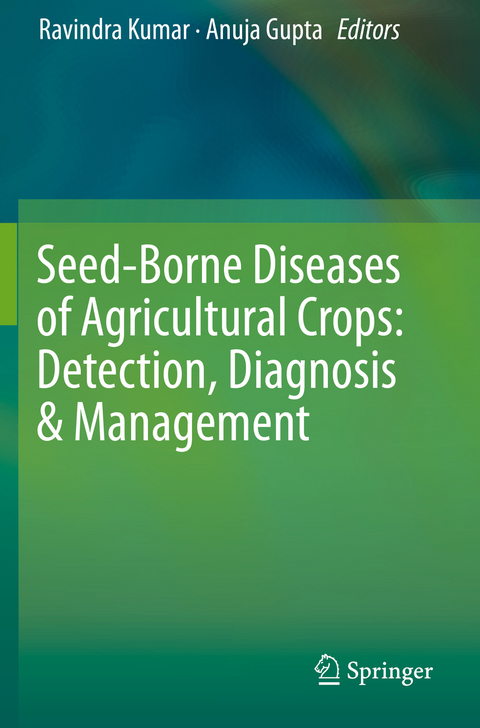
Seed-Borne Diseases of Agricultural Crops: Detection, Diagnosis & Management
Springer Verlag, Singapore
978-981-329-048-8 (ISBN)
The book "Seed-Borne Diseases of Agricultural Crops: Detection, Diagnosis & Management" addresses key issues related to seed-borne/transmitted diseases in various agricultural crops. Divided into 30 chapters, it offers a comprehensive compilation of papers concerning: the history of seed pathology, importance of seed-borne diseases, seed-borne diseases and quarantine, seed health testing and certification, detection and diagnosis of seed-borne diseases and their phytopathogens, host-parasite interactions during development of seed-borne diseases, diversity of seed-borne pathogens, seed-borne diseases in major agricultural crops, non-parasitic seed disorders, mechanisms of seed transmission and seed infection, storage fungi and mycotoxins, impact of seed-borne diseases on human and animal health, and management options for seed-borne diseases.
We wish to thank all of the eminent researchers who contributed valuable chapters to our book, which will be immensely useful for students, researchers, academics, and all those involved in various agro-industries.
Dr. Ravindra Kumar is currently working as a Scientist Sr. Scale (Plant Pathology) at ICAR-Indian Agriculture Research Institute, Regional Station, Karnal-132 001 (Haryana). He received his B.Sc. (Ag.) from C.C.S. University, Meerut; and his M.Sc. (Ag.) and Ph.D. (Ag.) from the Department of Mycology and Plant Pathology, Banaras Hindu University, Varanasi, India. His areas of research interest are plant disease management, biological control, seed pathology, and plant microbe interaction. He has published more than 30 research papers and reviews in reputed national and international journals. He has 2 textbooks, 1 edited book, 5 book chapters, 8 technical bulletins, and more than 40 technical/popular articles to his credit. Dr Kumar is also a life member of the Indian Phytopathological Society, New Delhi; Indian Society of Mycology and Plant Pathology, Udaipur; and Indian Society of Seed Technology, New Delhi. Dr. Anuja Gupta is currently working as a Principal Scientist (Plant Pathology) at ICAR-Indian Agriculture Research Institute, Regional Station, Karnal-132 001 (Haryana). She received her M.Sc. and Ph.D. from Kurukshetra University, India. Her areas of research interest are management of plant diseases through IDM approaches, especially for healthy seed production, seed pathology, and enhancement of seed longevity. She has 36 research papers published in national and international journals, 11 book chapters, and 68 technical and popular articles to her credit. She has also edited 13 technical bulletins on various aspects of disease-free seed production. Dr Gupta is also a Fellow of the Indian Society of Seed Technology and Indian Phytopathological Society, New Delhi.
Part 1. Impact of seed borne phytopathogens or seed borne diseases on agriculture and society.- Chapter 1. Importance of Seed-borne Diseases of Agricultural Crops: Economic losses and Impact on Society.- Chapter 2. Major Seed-borne Diseases of Agricultural Crops: International Trade of Agricultural Products and Role of Quarantine.- Part II. History of seed pathology.- Chapter 3. Contribution of Individuals and Organizations in the Development of Seed Pathology.- Chapter 4. Ancient, Mid-time and Recent History of Seed Pathology.- Part III. Diagnosis & detection of seed borne pathogens.- Chapter 5. Diagnosis and detection of Seed borne fungal phytopathogens.- Chapter 6. Detection of Seed and Propagating Material Borne Bacterial Diseases of Economically Important Crops.- Chapter 7. Detection and diagnosis of seed-borne viruses and virus like pathogens.- Chapter 8. Detection and diagnosis of seed borne and seed associated nematode.- Part IV. Host – parasite interaction during thedevelopment of seed borne diseases.- Chapter 9. Host-parasite Interaction During Development of Major Seed-borne Fungal Diseases.- Chapter 10. Host-parasite interaction during development of major seed borne bacterial diseases.- Chapter 11. Host-parasite interaction during development of major seed transmitted viral diseases.- Part V. Diversity of seed borne phytopathogens.- Chapter 12. Diversity of seed borne fungal phytopathogens.- Chapter 13. Diversity of seed borne bacterial phytopathogens.- Chapter 14. Genetic diversity, transmission and understanding of seed-borne viruses and phytoplasma.- Chapter 15. Diversity of Seed Borne and Seed Associated Nematodes.- Part VI. Major Seed borne diseases in different agricultural crops.- Chapter 16. Major Seed borne diseases in important cereals: Symptomatology, etiology & economic importance.- Chapter 17. Major Seed borne diseases in important oilseeds: Symptomatology, etiology & economic importance.- Chapter 18. Major Seed borne diseases in important pulses: Symptomatology, etiology & economic importance.- Chapter 19. Major Seed borne diseases in important vegetables: Symptomatology, etiology & economic importance.- Chapter 20. Major Seed borne diseases in important forage crops & fibre crops: Symptomatology, etiology & economic importance.- Part VII. Seed borne diseases: Human and animal health.- Chapter 21. Seed borne diseases: its impact on Human and animal health.- Part VIII. Management of seed borne pathogens/diseases.- Chapter 22. Use of Biological Control Agents in the Management of Seedborne Diseases.- Chapter 23. Chemical Management of seed borne diseases: Achievements and future challenges.- Chapter 24. Biotechnology: An intervention for the genetic resistance against seed borne phytopathogens.- Chapter 25. Management of Seed borne diseases: An integrated approach.- Part IX: Mechanism of seed transmission and seed infection.- Chapter 26. Mechanism of Seed Transmission and SeedInfection in Major Agricultural Crops in India.- Part X: Miscellaneous.- Chapter 27. Seed Health Testing and Seed Certification.- Chapter 28. Non-Parasitic Seed Disorders of Major Agricultural Crops.- Chapter 29. Storage fungi and Mycotoxins.- Chapter 30. Epidemiology of seed borne diseases.
| Erscheinungsdatum | 03.06.2021 |
|---|---|
| Zusatzinfo | 99 Illustrations, color; 44 Illustrations, black and white; XIII, 871 p. 143 illus., 99 illus. in color. |
| Verlagsort | Singapore |
| Sprache | englisch |
| Maße | 155 x 235 mm |
| Themenwelt | Naturwissenschaften ► Biologie ► Botanik |
| Naturwissenschaften ► Biologie ► Genetik / Molekularbiologie | |
| Weitere Fachgebiete ► Land- / Forstwirtschaft / Fischerei | |
| ISBN-10 | 981-329-048-X / 981329048X |
| ISBN-13 | 978-981-329-048-8 / 9789813290488 |
| Zustand | Neuware |
| Haben Sie eine Frage zum Produkt? |
aus dem Bereich


